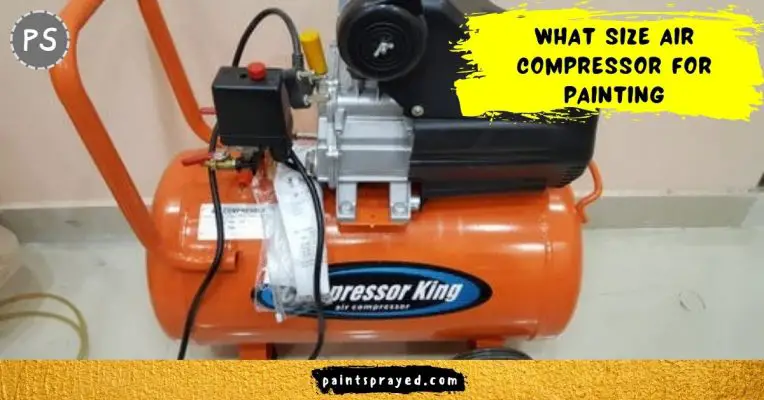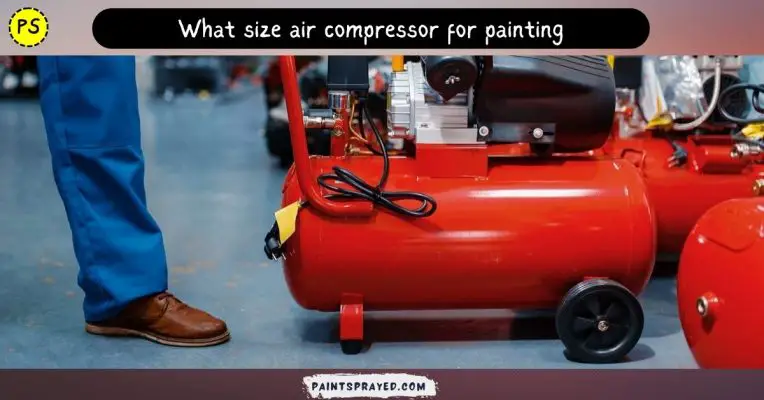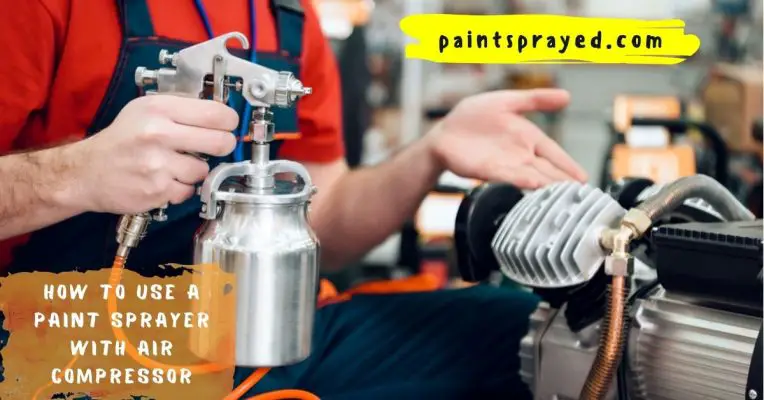In this guide, you will get information regarding air compressors that can be used for painting purposes.
And what size air compressors for painting are suitable to achieve satisfactory results without messing up the painting process.
If you are a newbie then you must read this blog post and don’t miss any point otherwise you can damage the surface which you are painting with an air compressor.
So, the answer to this question depends on various factors. It is based on the size of the work you are going to perform.
The types of paint you gonna use and so on the standards varies from situation to situation. Normal touchups have a different scenario than a full-body paint job.
What size of air compressor for painting?
Here I will explain those factors which are very important in choosing a size for an air compressor for painting purposes.
Because these factors can make or break the situation so note down these factors which I am gonna explain now.
The best size of air compressor for painting is one that can deliver enough air to power your paint gun.
A good rule of thumb is to choose an air compressor that can deliver at least 4 CFM (cubic feet per minute) of airflow.
If you plan on doing a lot of painting, or if you will be using your air compressor for other applications as well, you may want to consider a larger unit.
Tank capacity
When choosing an air compressor for painting, one of the key factors to consider is the size of the tank.
A larger tank will be able to hold more air, which means it can run for longer periods of time before needing to be refilled.
This is especially important if you are working on a large project or painting in a large space.
If you have a smaller tank, you may need to stop and refill it more often, which can disrupt your workflow.
CFM rating
When choosing an air compressor for painting, the CFM rating is an important factor to consider.
This rating measures the amount of air the compressor can deliver per minute, and is a key factor in determining the performance of the compressor.
A higher CFM rating means the compressor can deliver more air, and is, therefore, more suitable for painting applications.
Air pressure
Air compressors are an important part of the painting process, as they provide the air pressure necessary to operate airbrushes and other painting equipment.
There are a variety of air compressors on the market, and choosing the right one for your needs can be a challenge.
Air pressure is one of the most important factors to consider when choosing an air compressor for painting.

Higher air pressure means more power and can be useful for painting thicker layers of paint. However, too much air pressure can cause the paint to spatter and create a messy finish.
You’ll need to experiment to find the right air pressure for your project, but a good rule of thumb is to start with lower air pressure and increase it until you get the desired results.
Horsepower
Air compressors come in a variety of shapes and sizes, and each has its own set of capabilities.
When it comes to painting, the most important factor to consider is the compressor’s horsepower. Higher horsepower means more power and therefore a faster paint job.
But beware – too much power can cause the paint to spatter and create a messy finish.
Choose an air compressor with the right amount of horsepower for your project, and you’ll be sure to end up with a beautiful, professional-looking paint job.
Duty cycle
The duty cycle is an important factor to consider when choosing an air compressor for painting.
A duty cycle is the percentage of time in a given period that a compressor can be operated at full load.
For example, a compressor with a 50% duty cycle can be operated for 30 minutes out of every hour without exceeding the maximum recommended temperature for continuous operation.
When choosing an air compressor for painting, it is important to consider the duty cycle of the compressor.
A compressor with a higher-duty cycle will be able to handle more continuous use without overheating.
This is important when choosing an air compressor for painting because painting projects can often take a long time to complete.
Use cycle
When choosing an air compressor for painting, the use cycle is a factor to consider.
For example, if the compressor will be used for prolonged periods of time, a higher-grade model may be necessary.
If the compressor will be used intermittently, a lower-grade model may suffice. In addition, the size of the painting project will also dictate the size of the air compressor needed.
PSI rating
The PSI rating on an air compressor is a key factor to consider when choosing an air compressor for painting.
A higher PSI rating means the compressor can generate more air pressure, which is necessary for painting.
If the compressor cannot generate enough air pressure, the paint job will be poor.
In addition, a higher PSI rating means the compressor can run for longer periods of time without needing to be refilled.
This is important because it minimizes downtime and ensures a consistent air supply.
Duty cycle
When choosing an air compressor for painting, one of the key factors to consider is hose length.
A longer hose can be very helpful in reaching all areas of a painting project, while a shorter hose may be more manageable and easier to store.

Other factors to consider when choosing an air compressor for painting include the size of the tank, CFM (cubic feet per minute) output, and PSI (pounds per square inch) rating.
What size air compressor to paint a car?
The best size of air compressor for painting a car is one that can provide enough power to run the air tools you need, while also being portable enough to be easily moved around.
For most people, a portable air compressor that is at least 3-4 gallons will be sufficient. If you plan on using air tools regularly, then you may want to consider a larger air compressor.
How to paint a car with a small air compressor?
To paint a car with a small air compressor, you will need to purchase a few supplies. First, you will need to purchase an air compressor. You can find these at most hardware stores.
Second, you will need to purchase a paint gun. Again, you can find these at most hardware stores. Finally, you will need to purchase some paint. You can find this at any auto parts store.
Once you have all of your supplies, you will need to follow a few steps. First, you will need to clean the car. This is important because you want the paint to adhere to the car. Second, you will need to set up the air compressor.
This is relatively easy to do. Third, you will need to prime the paint gun. This is also easy to do. Fourth, you will need to paint the car.
This is the most difficult step, but with a little practice, you will be able to do it.
You will need to be very careful when you are painting the car. You want to make sure that you don’t get any paint on you.
Also, you want to make sure that you don’t get any paint on the ground. If you do, it will be very difficult to clean up.
Once you have finished painting the car, you will need to let it dry. This may take a few hours. Once it is dry, you will be able to enjoy your new paint job.
What size air compressor for painting a truck?
There is no definitive answer to this question as the best size of air compressor for painting will vary depending on the specific project you are working on.
However, as a general rule of thumb, a larger air compressor will be better suited for painting projects as it will be able to generate more air power to operate your paint sprayer.
If you are working on a smaller painting project, a smaller air compressor may be sufficient.
Ultimately, it is best to consult with a professional before beginning your project to ensure you have the proper equipment.
How to clean an air compressor?
After you finish painting, it’s important to clean your air compressor. Here’s how:
- Turn off the air compressor and unplug it from the power source.
- Drain the air compressor by releasing the pressure from the tank.
- Use a brush or rag to remove any paint from the exterior of the compressor.
- Use a wet/dry vacuum to remove any paint from the interior of the compressor.
- Once all the paint is removed, reassemble the air compressor and plug it back in.
What size compressor do I need for a paint sprayer?
The size of the compressor you need for a paint sprayer will depend on the type and model of the sprayer, as well as the type of paint you will be using.
In general, a compressor with at least 1.5 horsepower and a tank capacity of at least 20 gallons is recommended for most paint sprayers.
Additionally, the compressor should have an air flow rate of at least 7.0 CFM at 40 PSI, and at least 5.7 CFM at 90 PSI to support the paint sprayer.
It is also important to choose a compressor with a high enough PSI (pounds per square inch) rating to support the sprayer’s maximum PSI requirement.
What size air compressor do I need to paint a car?
To paint a car, you will need a compressor with a high enough CFM (cubic feet per minute) rating to support the air spray gun you will be using.
As well as a high enough PSI (pounds per square inch) rating to support the spray gun’s maximum PSI requirement.
For a small to medium-size car, a compressor with a CFM of 7 to 10, and a PSI of 40 to 50 is recommended. A compressor with a tank capacity of at least 20 gallons is also recommended.
However, it’s important to check the specifications of the spray gun you are using and to match them with the compressor’s capabilities.
Some professional spray guns can require much more CFM and PSI, in that case you should look for a compressor that can provide a minimum of 11-12 CFM at 90 PSI.
It’s also important to note that the bigger the compressor, the more powerful it will be, but it also tends to be more expensive and louder.
How many gallons of air compressor do I need for a paint gun?
The size of the air compressor tank you need for a paint gun will depend on the type and model of the gun, as well as the type of paint you will be using.
A general rule of thumb is that a compressor with a tank capacity of at least 20 gallons is recommended for most paint guns.
However, this can vary depending on the specific requirements of your paint gun, and the type of painting project you will be undertaking.
It’s important to check the specifications of the paint gun you are using, and to match them with the compressor’s capabilities.
Some paint guns require a high volume of air, and therefore a larger compressor tank.
For example, if the paint gun requires a high CFM (cubic feet per minute) and PSI (pounds per square inch).
A larger tank will be needed to store the necessary volume of air to keep up with the paint gun’s demands.
It’s also important to note that the bigger the compressor, the more powerful it will be, but it also tends to be more expensive and louder.
Is a 26 gallon air compressor good for painting?
A 26 gallon air compressor can be good for painting, depending on the specific requirements of your paint gun and the type of painting project you will be undertaking.
A 26 gallon compressor will typically have a larger tank, which can store more air and allow for longer periods of continuous use without needing to stop and recharge the tank.
This can be especially useful for larger painting projects or for professional use.
However, the capacity of the tank alone is not the only factor to consider when determining if a 26 gallon compressor is suitable for painting.
It’s important to check the specifications of the paint gun you are using, and to match them with the compressor’s capabilities.
The compressor should have a high enough CFM (cubic feet per minute) and PSI (pounds per square inch) rating to support the paint gun’s requirements.
It’s also important to note that, while a bigger compressor tends to be more powerful, it also tends to be more expensive and louder.
FAQ’s of What size air compressor for painting
Summary of what size air compressor for painting
This was the complete guide on the size of the air compressor for painting purposes for the newbies and those who didn’t know which size is optimal for spray guns.
If you are still confused, let me know in the comments section, and my professional painter fellows and I will answer your questions and clear your thoughts.
If you found this blog post helpful, do share it with your friends, family, and painter fellows who are learning to paint. Till next time take care of yourself and of your equipment.

Matthew Edward is a professional painter who loves to paint and wants to share useful tips and tricks which he had learned in many years of experience in painting. He also used many products that can be used for painting he has tried and tested each and every product to give an unbias opinion about it in his review. This blog is very useful for those newbies who want to learn painting without making mistakes.






